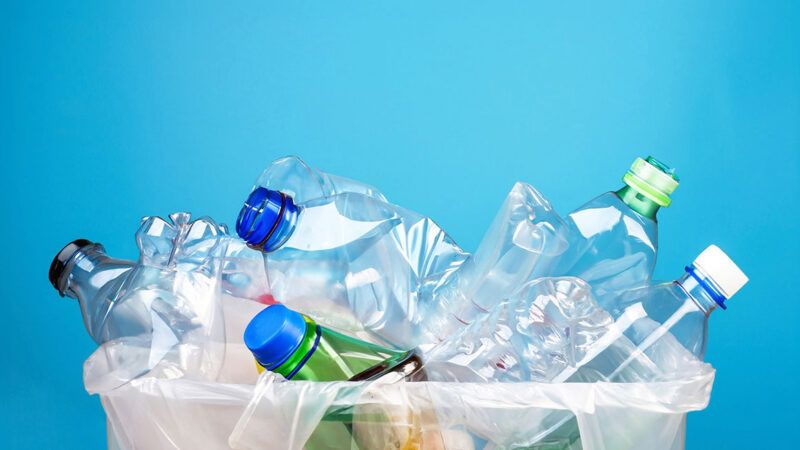Plastics Are Better for the Climate Than Aluminum and Glass, Actually
Producing plastics from fossil fuels emits a lot of carbon dioxide, but a new study finds the life cycle emissions are actually lower than glass and aluminum.

"Plastics are the new coal," declares Beyond Plastics. "Pollution from the plastics industry is a major force behind the heating of the planet," reports The Hill. The Natural Resources Defense Council says "reducing plastic production is critical to combatting climate change."
Producing plastics from fossil fuels emits a lot of carbon dioxide into the atmosphere, which contributes to warming the planet. An April study by researchers at the U.S. Department of Energy's Lawrence Berkeley National Laboratory estimates that in 2019 "global production of primary plastics generated about 2.24 gigatonnes of carbon dioxide equivalent," which represents 5.3 percent of total global greenhouse gas emissions. So switching to plastic alternatives would help slow man-made global warming, right?
Not so fast, says a new study in Environmental Science & Technology, which finds that "replacing plastics with alternatives is worse for greenhouse gas emissions in most cases." The European researchers report that in "15 of the 16 applications a plastic product incurs fewer greenhouse gas emissions than their alternatives."
The researchers considered emissions from production, transportation, use, and end-of-life disposal, including landfilling, incineration, recycling, and reuse. Calculating the product life cycles, plastic products release 10 percent to 90 percent fewer emissions than do plausible alternatives—often because it takes less energy to make and transport them.
Take the perennial plastic vs. paper conundrum about grocery bags. In the U.S., more than 500 cities and 12 states have banned plastic grocery bags. However, the researchers find that plastic grocery bags emit 80 percent fewer greenhouse gases than paper bags. Producing paper bags emits three times the greenhouse gases of plastic ones, and transportation emissions are higher because paper bags weigh six times more than plastic bags. Additionally, paper bags emit globe-warming methane as they rot in landfills.
Alternatives to plastic bottles are aluminum cans and glass bottles. Even though aluminum cans are often recycled, the researchers find that over their life cycle, they emit twice as many greenhouse gases as plastic bottles. Glass bottles emit three times more.
The United Nations is currently negotiating a global plastic pollution treaty. One option being considered is a global ban on "short-lived and single-use plastic products," which would likely include foam trays wrapped in thin film plastics used for packaging foods such as pork and beef. The researchers compare those packages with butcher paper and find that, including production and food spoilage emissions, using butcher paper wrapping emits 35 percent more greenhouse gases than plastics do.
In municipal construction, polyvinyl chloride (PVC) sewer pipes are compared to pipes made with concrete and ductile iron. PVC pipes emit 45 percent fewer greenhouse gases than concrete pipes do, and 35 percent less than iron pipes. In residential construction, pipes made with polyethylene (the most widely used commodity plastic) are marginally better than copper pipes, emitting 3 percent fewer greenhouse gases.
Plastic dining sets produce 50 percent fewer emissions than do wooden ones, due to differences in raw materials, manufacturing, transport, and weight. High-density polyethylene automobile fuel tanks weigh so much less than steel ones do that the fuel savings over their lifetimes amount to 90 percent fewer greenhouse gas emissions. Polyethylene terephthalate/nylon carpets emit 80 percent fewer greenhouse gases than wool carpets do.
The researchers did identify one case in which the likely alternative to plastics emits fewer greenhouse gases: 55-gallon industrial steel drums. Because steel drums last longer and are generally recycled, they emit 30 percent fewer greenhouse gases over their lifetimes than comparable plastic ones do.
Conventional alternatives for current plastics are generally a lot worse with respect to greenhouse gas emissions, the study suggests. The researchers conclude that "any action taken or policy employed to reduce the impacts of plastics needs to be examined carefully to make sure that greenhouse gas emissions are not unintentionally increased through a shift to more emission-intensive alternative materials."
The good news is that some companies and researchers are developing nearly endlessly recyclable plastics. Currently, UBQ Materials turns unsorted household wastes including single-use plastics into thermoplastics that can be subsequently recycled as many as five times—a process that cuts greenhouse gas emissions by more than 90 percent. In addition, researchers at the Lawrence Berkeley National Laboratory have developed an "infinitely recyclable" bio-based plastic called polydiketoenamine that cuts greenhouse gas emissions by nearly 98 percent compared to conventional plastics.
As the debate over plastics and their alternatives continues, it's crucial to consider the full environmental impact of our choices and embrace innovations that actually reduce greenhouse gas emissions and protect our planet.
This article originally appeared in print under the headline "Plastics Are Better for the Climate."

